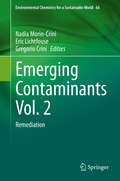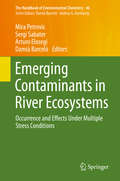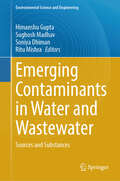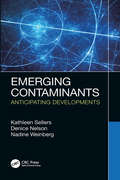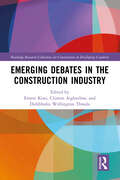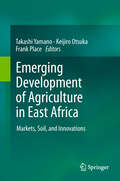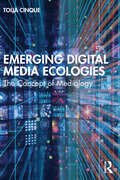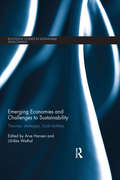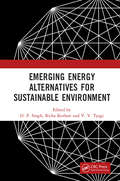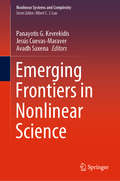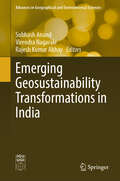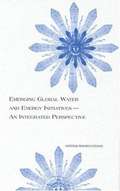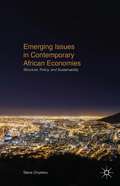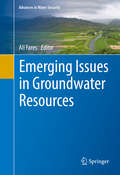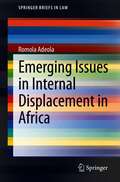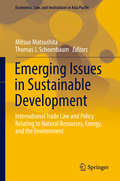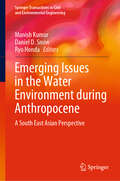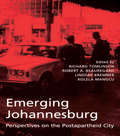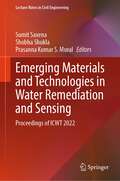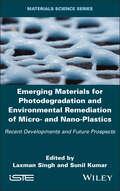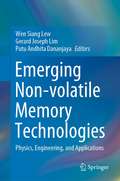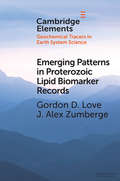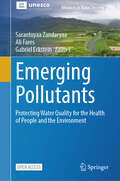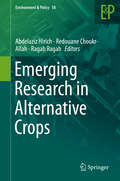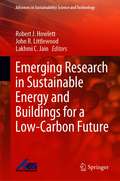- Table View
- List View
Emerging Contaminants Vol. 2: Remediation (Environmental Chemistry for a Sustainable World #66)
by Eric Lichtfouse Grégorio Crini Nadia Morin-CriniEmerging contaminants are chemical and biological agents for which there is growing concern about their potential health and environmental effects. The threat lies in the fact that the sources, fate and toxicology of most of these compounds have not yet been studied. Emerging contaminants, therefore, include a large number of both recently discovered and well-known compounds such as rare earth elements, viruses, bacteria, nanomaterials, microplastics, pharmaceuticals, endocrine disruptors, hormones, personal care products, cosmetics, pesticides, surfactants and industrial chemicals. Emerging contaminants have been found in many daily products, and some of them accumulate in the food chain. Correlations have been observed between aquatic pollution by emerging contaminants and discharges from wastewater treatment plants. Most actual remediation methods are not effective at removing emerging contaminants. This second volume presents comprehensive knowledge on emerging contaminants with a focus on remediation.
Emerging Contaminants in River Ecosystems
by Sergi Sabater Damià Barceló Mira Petrovic Arturo ElosegiThis volume offers an overview of the occurrence of emerging organiccontaminants in Mediterranean rivers and their relevance to their chemical and ecologicalquality under water scarcity. With chapters covering the effects under multiple stressconditions of pharmaceuticals, polar pesticides, personal care products, and industrialchemicals, the observations presented can be applicable to other parts of theworld where water scarcity is an issue . It is of interest to environmentalchemists, ecologists, environmental engineers, and ecotoxicologists, as well aswater managers and decision-makers.
Emerging Contaminants in Water and Wastewater: Sources and Substances (Environmental Science and Engineering)
by Himanshu Gupta Sughosh Madhav Ritu Mishra Soniya DhimanThis present book serves as a comprehensive compilation of various emerging contaminants in the ecosystem, their contamination risk as well as the applicable remediation techniques. Exploding urbanization and industrialization often combined with improved standards of living have resulted in deleterious effects on the quality of the environment. Due to rapid growth of industrialization in the past few decades, large amounts of undesirable wastes are being discharged into the environment threatening the survival of living beings on the earth. In the recent years, the problems regarding pollution have become more global, and awareness about the environmental problems is increasing continuously. Environmental awakening has led many scientists to focus on the assessment of environmental impact of various emerging contaminants. The first victims of the environmental pollution are the terrestrial plants and aquatic bodies in the vicinity of urban areas that experience heavy pollution due to industrial effluents, toxic chemicals, hospital waste, radioactive waste, industrial fumes, vehicular traffic, etc. The increasing industrialization and use of hazardous chemicals are responsible for the lack of access to clean water in many parts of the world. In view of the widespread occurrence, persistence, and harmful effects of environmental pollutants on human population, the present book is proposed. Emerging contaminants due to ubiquitous distribution, persistence, and toxic effects have necessitated the development of efficient methods for remediation of contamination. Reports appearing from time to time reveal that the number and concentration of contaminants in the environment are continuously increasing. Thus, development as well as dissemination of new and eco-friendly methods for the removal of these pollutants has become a challenging task.
Emerging Contaminants: Anticipating Developments
by Kathleen Sellers Denice K. Nelson Nadine WeinbergEmerging Contaminants: Anticipating Developments examines the factors that have led "new" environmental contaminants to emerge in the past and combines the lessons learned to anticipate potential new developments. The analyses described in this book originate in multiple disciplines: the science of toxicology; environmental law and regulation; the field of product stewardship; and the social science which explains why ideas take hold. Over a dozen case studies of contaminants that emerged as environmental issues over the last hundred years illustrate crucial points. The results of the analyses in this book support a step-by-step method to assess the potential for a contaminant to emerge, and a framework to apply those conclusions to managing site liabilities. Features: Describes an unprecedented understanding of why contaminants emerge as issues, based on a multidisciplinary analysis Makes abstract concepts tangible, basing analyses on data and illustrating key points with case studies Enables readers to anticipate and prepare to manage future challenges associated with emerging chemicals Presents an analytical framework for companies to assess and manage business risks Written for regulators, policymakers, industry professionals with responsibility for contaminated site management, as well as attorneys, and consultants, this book provides a framework for anticipating the emergence of new contaminants so that the risks–whether to human health and the environment or to a business–can be anticipated and appropriately managed.
Emerging Debates in the Construction Industry: The Developing Nations’ Perspective (Routledge Research Collections for Construction in Developing Countries)
by Clinton Aigbavboa Ernest Kissi Didibhuku Wellington ThwalaThis book provides readers with an insightful understanding of the various emerging issues in the construction industry, especially in the area associated with United Nations developmental goals, 4th Industrial Revolution, Health and Safety, Sustainability, Skills and Capacity development. The need for all practitioner to understand growing issues surrounding the various evolving concepts or technologies in the construction industry remain critical to stakeholders if any meaningful gains are expected. This book explains the importance of inclusion, health and safety, skills development, collaboration, pandemics, the fourth industrial revolution, capacity building, and green finance, among others. Thus, it provides an in-depth understanding of the issues mentioned in developed and developing countries for construction professionals, researchers, educators, and other stakeholders. The book can be adopted as a research guide, framework, and reference on the emerging concepts in construction practices.
Emerging Development of Agriculture in East Africa
by Frank Place Keijiro Otsuka Takashi YamanoEmerging Development of Agriculture in East Africa offers case studies that find promise in many new innovations. Farmers in Uganda have quickly learned the management of NERICA rice (a new upland rice variety), which is being disseminated in a limited way in the region. Also in Uganda, farmers living in more remote areas have improved access to markets due to the expansion of mobile phones. In Kenya, improved milk marketing systems have increased efficiency and led to tangible increases in the adoption of dairy production technologies. And the adoption of intensive dairy production systems in Kenya and Uganda are providing significant amounts of manure and positively impacting yields of maize and banana.
Emerging Digital Media Ecologies: The Concept of Medialogy
by Toija CinqueEmerging Digital Media Ecologies: The Concept of Medialogy investigates the profound ways in which digital media reshapes our cultural, socio-technological, political, and natural landscapes. Through interdisciplinary empirical and creative case studies, the book defines and illuminates the nuances of medialogy, emphasising the often-underestimated impact of emerging technologies across interactive education, data gathering, visual-data representations, and creative practice. It explores the intersection of the natural and technological worlds, contextualising our use of natural resources against climate change and sustainable economies.Divided into two parts, the book delves into the theoretical underpinnings of digital media ecologies and their practical applications. Part 1 traces the evolution of media technologies, examining their environmental impact and the foundational approaches to understanding media’s complex interconnections. Part 2 focuses on contemporary issues such as hyperpersonalised media, digital literacy, and the transformative power of Indigenous media narratives.Additionally, the monograph explores the revolutionary role of Artificial Intelligence (AI) and large language models like ChatGPT-4o and those that follow in shaping our digital future. It investigates how AI transforms creative practices, data processing, and communication, contributing to the formation of new media ecologies. The ethical implications, commodification, identity formation, and the impact of AI-driven technologies on everyday life are critically examined, offering insights into the future of human–technology interactions.This book is a crucial reference for scholars, practitioners, and students in digital humanities, media studies, environmental humanities, and anyone interested in the cultural implications of emerging digital technologies and their impact on our environment and society.
Emerging Economies and Challenges to Sustainability: Theories, strategies, local realities (Routledge Studies in Sustainable Development)
by Arve Hansen Ulrikke WethalThe rise of emerging economies represents a challenge to traditional global power balances and raises the question of how we can combine sustainability with continued economic growth. Understanding this global shift and its impact on the environment is the paramount contemporary challenge for development-oriented researchers and policy makers alike. This book breaks new ground by combining scholarship on the role of emerging economies with research on sustainable development. The book investigates how the development strategies of emerging economies challenge traditional development theory and sustainability discourses. With regional introductions and original case studies from South Asia, East Asia, Latin America and Sub-Saharan Africa, it discusses how to conceptualise sustainable development in the global race for economic prosperity. What characterises the development strategies of emerging economies, and what challenges are these posing for global sustainable development? How can emerging economies shed light on the global challenges, dilemmas and paradoxes of the relationship between socio-economic improvements and environmental degradation? This book will be a valuable resource for researchers and postgraduates in development studies, geography, economics and environmental studies.
Emerging Energy Alternatives for Sustainable Environment
by Richa Kothari D. P. Singh V. V. TyagiSustainability of environment is an emerging global issue at present. Unsustainable or deteriorating environment is a matter of concern as it has threatened the survival of living creatures. Recently, climate change has been a matter of great concern at a global platform owing to imbalances in natural environment. Increasing population has increased the demand for energy, which has ultimately put pressure on natural resources and caused a paradigm shift from resource generation to exploitation. Emerging Energy Alternatives for Sustainable Environment aims to address the role of sustainable technologies in energy generation options for clean environment. It covers a wide spectrum of energy generation approaches, with an emphasis on five key topics: (i) renewable energy sources and recent advances, (ii) emerging green technologies for sustainable development, (iii) assessment of biomass for sustainable bioenergy production, (iv) solid waste management and its potential for energy generation, and (v) solar energy applications, storage system, and heat transfer. This book provides essential and comprehensive knowledge of green energy technologies with different aspects for engineers, technocrats and researchers working in the industry, universities, and research institutions. The book is also very useful for undergraduate and graduate students of science and engineering who are keen to know about the development of renewable energy products and their corresponding processes. Please note: This volume is Co-published with The Energy and Resources Institute Press, New Delhi. Taylor & Francis does not sell or distribute the Hardback in India, Pakistan, Nepal, Bhutan, Bangladesh and Sri Lanka
Emerging Frontiers in Nonlinear Science (Nonlinear Systems and Complexity #32)
by Avadh Saxena Jesús Cuevas-Maraver Panayotis G. KevrekidisThis book explores the impact of nonlinearity on a broad range of areas, including time-honored fields such as biology, geometry, and topology, but also modern ones such as quantum mechanics, networks, metamaterials and artificial intelligence. The concept of nonlinearity is a universal feature in mathematics, physics, chemistry and biology, and is used to characterize systems whose behavior does not amount to a superposition of simple building blocks, but rather features complex and often chaotic patterns and phenomena. Each chapter of the book features a synopsis that not only recaps the recent progress in each field but also charts the challenges that lie ahead. This interdisciplinary book presents contributions from a diverse group of experts from various fields to provide an overview of each field’s past, present and future. It will appeal to both beginners and seasoned researchers in nonlinear science, numerous areas of physics (optics, quantum physics, biophysics), and applied mathematics (ODEs, PDEs, dynamical systems, machine learning) as well as engineering.
Emerging Geosustainability Transformations in India (Advances in Geographical and Environmental Sciences)
by Subhash Anand Virendra Nagarale Rajesh Kumar AbhayThis book presents the emerging sustainability concerns for India to achieve holistic development. India is densely populated with scattered natural resources and is engaged in developing technology and its infrastructure. However, India’s sustainability is questioned from the viewpoints of environment, society, economy and politics. As the Sustainable Development Goals (SDGs) aims to achieve a sustainable world by 2030, India has to relook at its current development approaches and make effective policy measures. Geography is an interdisciplinary branch of social science that focuses on the interrelationships among population, natural resources, social linkages, governments and public policy. Within this interdisciplinary concept, the book presents a collection of studies from scholars in India. We ask questions such as, (1) what major geographical approaches and perspectives exist related to sustainability, (2) how socioeconomic and political factors affects sustainability and SDGs, (3) what approach is the most effective from the sustainability perspective, and (4) how we address sustainability issues. The book serves as a valuable reference for those who are concerned with the progress of sustainability in India.
Emerging Global Water and Energy Initiatives-- An Integrated Perspective
by Global Energy Water Cycle Experiment Gewex PanelThe National Academies Press (NAP)--publisher for the National Academies--publishes more than 200 books a year offering the most authoritative views, definitive information, and groundbreaking recommendations on a wide range of topics in science, engineering, and health. Our books are unique in that they are authored by the nation's leading experts in every scientific field.
Emerging Issues In Contemporary African Economies
by Steve OnyeiwuIn Emerging Issues in Contemporary African Economies, Onyeiwu focuses on how events of the twenty-first century are shaping key sectors of African economies and societies. He argues that while there have been significant improvements in African economies, major challenges still remain. Onyeiwu implicitly adopts an evolutionary methodology that recognizes the capacities of African countries to learn from past policy mistakes, experiment with new policy initiatives, and adapt to evolvingeconomic challenges and opportunities. This great contribution to the literature explores new themes that have become central to the sustainable performance of African economies: the IT revolution, industrial dynamics, innovation and technological change, youth and gender, as well as issues around structural transformation.
Emerging Issues in Groundwater Resources
by Ali FaresThis book discusses how emerginggroundwater risks under current and potential climate change conductions reduceavailable groundwater resources for domestic use, and agriculture and energyproduction. The topics discussed throughout this book are grouped into fivesections; (i) Sea Level Rise, Climate Change, and Food Security, (ii) EmergingContaminants, (iii) Technologies and Decision Support Systems, (iv) SurfaceWater-Groundwater Interactions, and (v) Economics, and Energy Production andDevelopment. This book is unique and different from othergroundwater hydrology books in that it uses a holistic approach ininvestigating the risks related to groundwater resources. This book will be ofinterest to a wide audience in academia, governmental and non-governmentalorganizations, and environmental entities. This book will greatlycontribute to a better understanding of the emerging risks to groundwaterresources and should help responsible stakeholders make informed decisions inthis regard.
Emerging Issues in Internal Displacement in Africa (SpringerBriefs in Law)
by Romola AdeolaThis book focuses on emerging issues related to internal displacement in Africa. The six principal issues discussed are climate change, technology, xenophobia, harmful practices, generalized violence and development projects. Increasingly, the need to understand the root causes of the dimensions of internal displacement and the dimensions in which this displacement manifests have become a pertinent rhetoric in the discussion on internal displacement. Therefore, this monograph examines emerging issues for which there is very little in the internal displacement discussion, with the aim of providing knowledge within African regional contexts to advance law and policy formation. The novelty of this book lies in the fact that it moves beyond the conventional discussion on internal displacement into grey areas on the subject in Africa, leveraging the African Union Convention for the Protection and Assistance of Internally Displaced Persons (the Kampala Convention). This book will be a significant reference point for researchers, professors, practitioners, judges, policy makers, international organizations, regional bodies, lawyers and scholars in the fields of migration, forced migration, and regional institutions.
Emerging Issues in Sustainable Development
by Mitsuo Matsushita Thomas J. SchoenbaumThis book seeks to answer the questions: how do the rules of international treaties on trade and investment apply to the new laws and policies relating to energy-related trade, and do the rules of the multilateral system contribute to or detract from sustainable development? An emerging set of new problems in the law of international trade is how to reconcile the rules of the multilateral trading system with shortages of certain natural resources and the necessity to develop renewable energy resources. The chapters in this book provide a comprehensive analysis of the international trade issues presented by national trade laws and policies with regard to natural resources and energy. This book is about the extent to which we are interpreting existing rules to cover emerging problems and how the rules of the multilateral trading system can be adapted to achieve sustainable development in natural resources and energy. The book begins with a survey of selected national laws relating to recent restrictions on the export of natural resources, both resources used to produce energy as well as natural resources essential for industrial production. After examining the range of such laws in selected important countries, we turn to the application of the rules of the multilateral trading system to such export restrictions. We discuss the major rules of the World Trade Organization (WTO) as well as the natural resources rules in selected regional preferential free trade agreements. While there is not a comprehensive global legal regime on competition law, we believe it is also important to examine how selected national competition laws impact export restrictions on natural resources. This book will be a major contribution to the international dialogue on international economic law issues with respect to trade in natural resources and energy.
Emerging Issues in the Water Environment during Anthropocene: A South East Asian Perspective (Springer Transactions in Civil and Environmental Engineering)
by Manish Kumar Daniel D. Snow Ryo HondaThis book intends to bring together and integrate the subject matter of water quality. The book covers aspects of water related to climate change, emerging aspects of engineering sciences, bio-geochemical sciences, hydro geochemistry, river management and morphology, social sciences, and public policy. The book covers the role of disruptive innovations in water management, policy formation and impact mitigation strategies. The book includes lab results as well as case studies. It provides recommendations and solutions for policy making and sustainable water management. The chapters in this book deal cohesively with many aspects of the water environment during the Anthropocene era. The contents cover myriad issues, such as land degradation, water scarcity, urbanization, climate change, and disruptive innovation. The book also discusses issues highly pertinent to society and sustainability, such as the prevalence of enteric viruses and pharmaceutical residues as a possible anthropogenic markers in the aquatic environment. The book will prove useful for students, professionals, and researchers working on various aspects of water related concerns.
Emerging Johannesburg
by Richard Tomlinson Robert A. Beauregard Xolela Mangcu Lindsay BremnerJohannesburg is most often compared with Sao Paulo and Los Angeles and sometimes even with Budapest, Calcutta and Jerusalem. Johannesburg reflects and informs conditions in cities around the world. As might be expected from such comparisons, South Africa's political transformation has not led to redistribution and inclusive social change in Johannesburg. In Emerging Johannesburg the contributors describe the city's transition from a post apartheid city to one with all too familiar issues such as urban/suburban divide in the city and its relationship to poverty and socio-political power, local politics and governance, crime and violence, and, especially for a city located in Southern Africa, the devastating impact of AIDS.
Emerging Materials and Technologies in Water Remediation and Sensing: Proceedings of ICWT 2022 (Lecture Notes in Civil Engineering #439)
by Sumit Saxena Shobha Shukla Prasanna Kumar S. MuralThis book presents the select proceedings of 2nd International Conference on Water Technologies 2022. While several efforts are underway, materials form the core of all research activities to develop technologies to mitigate the global challenge of water crisis. This book includes latest scientific dialogues, state-of-the-art developments in terms of emerging materials, technology development aimed toward mitigating various bottlenecks in water treatment, purification, desalination, and sensing with emerging materials. It also discusses diverse materials driven approaches, including theoretical and experimental studies, to address various aspects of this global issue. The book discusses various topics related to nanomaterials for water purification, bio-physical remediation, photocatalysis, membranes, physico-chemical processes, oil-water separation, sensors, and microplastics, etc. The book can be a valuable reference for beginners, researchers, and professionals interested in water technologies and allied fields.
Emerging Materials for Photodegradation and Environmental Remediation of Micro- and Nano-Plastics: Recent Developments and Future Prospects (ISTE Invoiced)
by Sunil Kumar Laxman SinghEmerging Materials for Photodegradation and Environmental Remediation of Micro- and Nano-Plastics provides an in-depth understanding of the materials, design choices and applications needed for the mitigation of micro- and nano-plastic pollutants from environmental wastewater. This is a topic that continually attracts attention worldwide. This is an important book for academic institutes and libraries, scientific organizations, and global research industries, and has been created for a wide audience. The book provides the scope of material design, synthesis, detailed mechanisms, spectroscopic analysis, and problem-solving strategies in environmental remediation. The scope of the book on reactive, functional materials and applications extends far beyond the emerging technologies that possess valuable insights of the synthesis, processing and physiochemical characteristics and their functional properties for academics, postgraduates, research scholars, scientists, technologists, environmental chemists and industrialists. This book presents fifteen chapters, which explore new ideas in processing, designing, synthesis, selection, application, photocatalytic efficiency and economic justifications of emerging materials.
Emerging Non-volatile Memory Technologies: Physics, Engineering, and Applications
by Wen Siang Lew Gerard Joseph Lim Putu Andhita DananjayaThis book offers a balanced and comprehensive guide to the core principles, fundamental properties, experimental approaches, and state-of-the-art applications of two major groups of emerging non-volatile memory technologies, i.e. spintronics-based devices as well as resistive switching devices, also known as Resistive Random Access Memory (RRAM). The first section presents different types of spintronic-based devices, i.e. magnetic tunnel junction (MTJ), domain wall, and skyrmion memory devices. This section describes how their developments have led to various promising applications, such as microwave oscillators, detectors, magnetic logic, and neuromorphic engineered systems. In the second half of the book, the underlying device physics supported by different experimental observations and modelling of RRAM devices are presented with memory array level implementation. An insight into RRAM desired properties as synaptic element in neuromorphic computing platforms from material and algorithms viewpoint is also discussed with specific example in automatic sound classification framework.
Emerging Patterns in Proterozoic Lipid Biomarker Records (Elements in Geochemical Tracers in Earth System Science)
by Gordon D. Love J. Alex ZumbergeDiverse and abundant lipid biomarker assemblages have been reported from a variety of Proterozoic marine environments from the careful analysis of well-preserved rocks and oils. These molecular biosignatures have provided unique insights into the communities and the environmental conditions which characterized the Proterozoic marine biosphere. We summarize some of the major temporal patterns evident in Proterozoic lipid biomarkers found to date, whilst emphasizing the scale of local heterogeneity found within Neoproterozoic oceans from region to region, and their relationship with the evolving ecological, climatic and ocean/atmospheric redox conditions. Short commentaries on a selection of papers published from the last 15 years of biomarker literature are given. The focus here is on key studies, highlighted for further reading, which have helped to better constrain the timing of the ecological expansion of eukaryotes in Proterozoic oceans or which have impacted on our knowledge of the biological sources of Proterozoic biomarkers.
Emerging Pollutants: Protecting Water Quality for the Health of People and the Environment (Advances in Water Security)
by Ali Fares Gabriel Eckstein Sarantuyaa ZandaryaaThis open access book focuses on the importance of reducing pollution and protecting water resources for the health of people and the environment. Water is vital for life on Earth. The quality of the world's freshwater resources is deteriorating due to the rise in pollution levels, which puts the health of people and the environment at risk. Emerging pollutants, a new class called Contaminants of Emerging Concern, pose a global water quality challenge. The identification and implementation of appropriate regulatory, monitoring, prevention, and control measures are hindered by limited scientific understanding and knowledge about sources and pathways of emerging pollutants, their behaviour and fate in the environment, and potential human and ecosystem health risks. The book presents selected contributions to the UNESCO-IWRA Online Conference “Emerging Pollutants: Protecting Water Quality for the Health of People and the Environment,” held on 17–19 January 2023. It offers an extensive overview of current research findings on emerging pollutants in aquatic ecosystems, groundwater contamination, wastewater management and reuse, circular economy approaches to pollutant lifecycle management, and the prioritization of emerging pollutants in the hydro-cycle. Based on scientific evidence and policy-relevant research findings, the book’s concluding chapter highlights research and policy gaps, offering recommendations for strategic and practical ways to manage emerging pollutants towards sustainable water management in the face of global changes and evolving environmental threats. This book is a scientific output in the framework of UNESCO Intergovernmental Hydrological Programme’s Ninth Phase “Science for a Water-Secure World in a Changing Environment” (IHP-IX, 2022-2029) and UNESCO-IHP’s International Initiative on Water Quality (IIWQ) in collaboration with the International Water Resources Association (IWRA).
Emerging Research in Alternative Crops (Environment & Policy #58)
by Ragab Ragab Redouane Choukr-Allah Abdelaziz HirichThis book provides case studies on cultivating alternative crops and presents new cropping systems in many regions of the world. It focusses on new emerging research topics aiming to study all aspects of adaptation under several stresses including agricultural, environmental, biological and socioeconomic issues. The book also provides operational and practical solutions for scientists, producers, technology developers and managers to succeed the cultivation of new alternative crops and, consequently, to achieve food security.Many regions in the world are suffering from water scarcity, soil and water salinization and climate change. These conditions make it difficult to achieve food security by cultivating conventional crops. A renaissance of interest for producing alternative crops under water scarcity and water salinization has been, therefore, implemented primarily among small-scale producers, researchers and academics.The use of alternative crops (quinoa, amaranth, legume crops, halophytes, …etc.) may provide some environmental benefits such as valorization of salt-affected soils, reduced pesticide application, enhanced soil and water quality and promotion of wildlife diversity. This also may provide some economic benefits such as providing the opportunity for producers to take advantage of new markets and premium prices, spreading the economic risk and strengthening local economies and communities. Furthermore, alternative crops are often rich in proteins and minerals, and even some of them are Gluten free (quinoa). This reflects their importance to achieve food security in quantity and quality scale. The year 2013 was exceptional for alternative crops as it was the international year of quinoa celebrated by Food and Agriculture Organization (FAO). This reflects the importance of research conducted on quinoa and other alternative crops in many regions of the world.
Emerging Research in Sustainable Energy and Buildings for a Low-Carbon Future (Advances in Sustainability Science and Technology)
by Lakhmi C. Jain Robert J. Howlett John R. LittlewoodThis book contains an introduction and 20 studies, each describing a recent research investigation in the area of sustainable and resilient buildings, built environment infrastructure and renewable energy. Contributions are from many different countries of the world and on a range of topics, representing a sample of research within the ‘sustainable energy and buildings’ field. The book begins with chapters on the sustainable design of buildings, followed by descriptions of issues relating to the renovation, restoration and reconstruction of existing buildings, or in one case a railway wagon. The next part of the book covers factors that form barriers or impediments to low or zero carbon buildings, followed by studies of issues relating to policy and certification. There then follow four chapters on various topics related to sustainable buildings – undergraduate courses, insurance issues, biophilia relating to buildings and thermal conductivity measurement. There are several chapters relating to renewable energy, followed by two chapters with a sustainable transport theme, one relating to electric vehicles, and the other about a sustainable road infrastructure. The final chapter is on the manufacture of sustainable building components for the UK housing sector. The book is of use to engineers, scientists, researchers, practitioners, academics and all those who are interested to develop and use sustainability science and technology for the betterment of our planet and humankind, and to mitigate climate change reality.
